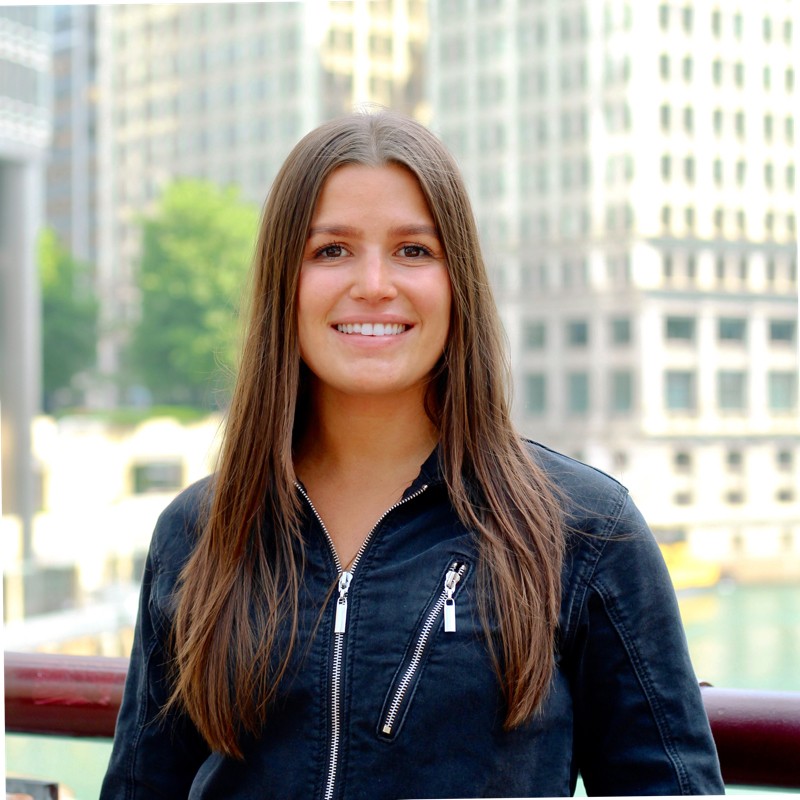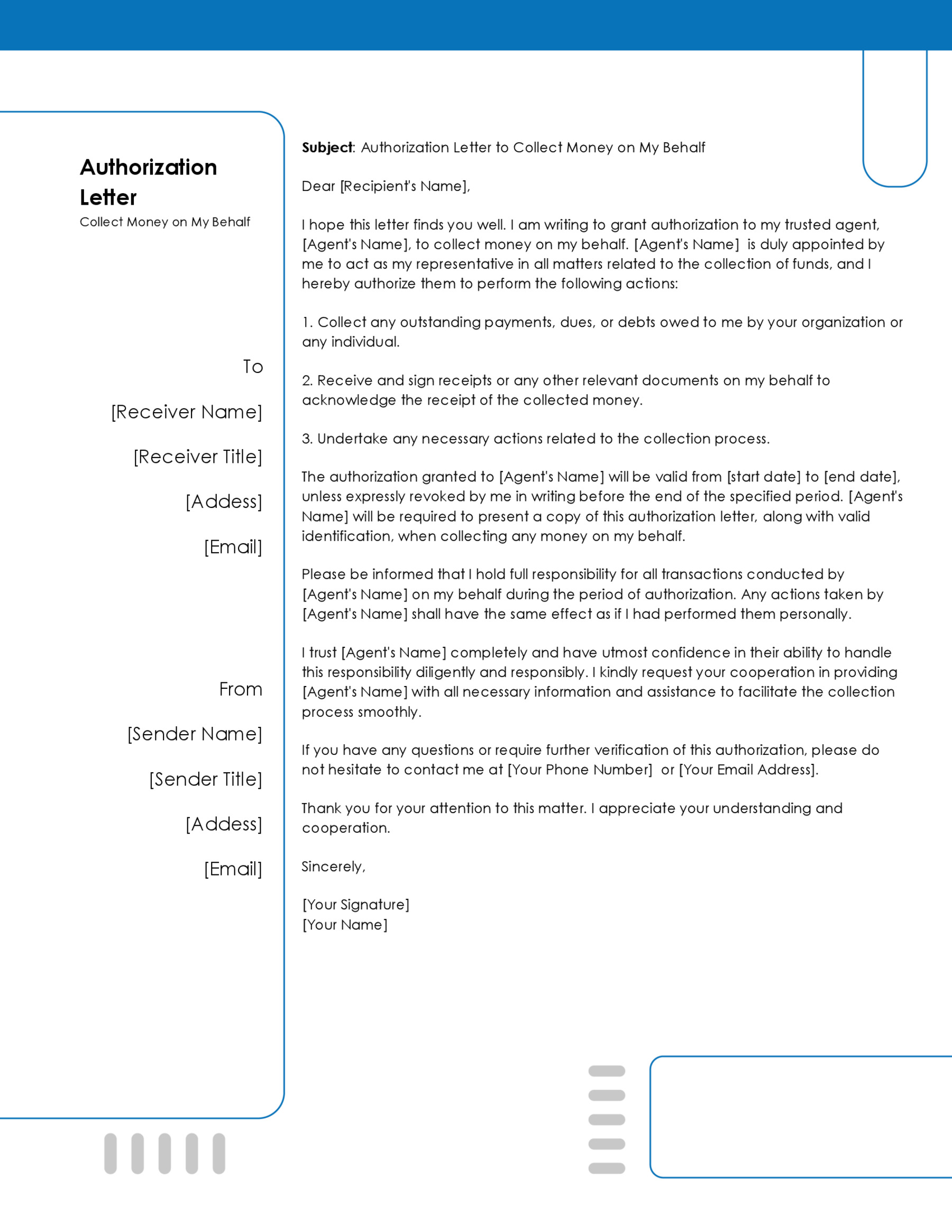The choice to make a career change can help set individuals on their desired employment paths. Simply sending a resume can confuse the hiring manager and lead to the dismissal of your application. Writing a cover letter for career change will enable you to outline qualifications, experiences, and transferable skills that make them perfect for the positions they hope to transition to.
You should only use half a page to provide the details to ensure that the career change cover is brief. It should have 3 to 4 paragraphs of between 200 to 400 words. This cover letter should contain a header, a greeting, an opening paragraph, a body, closing lines, a sign-off, and a signature.
Examples and Templates
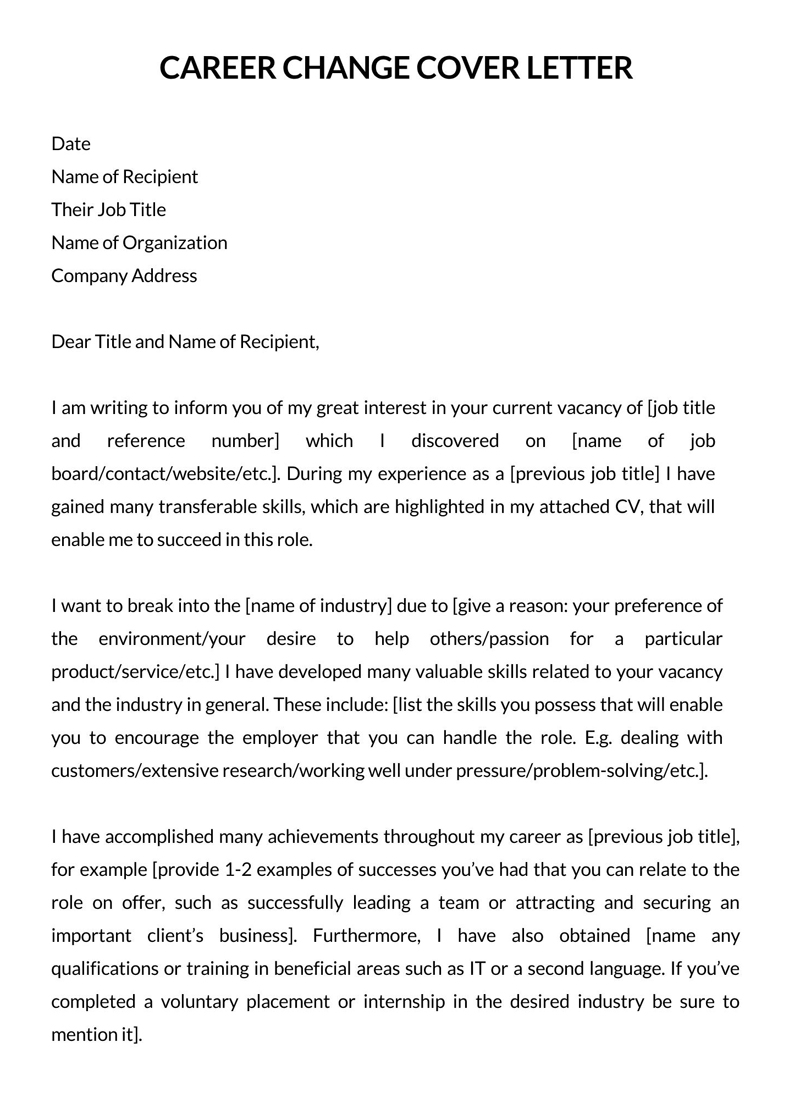
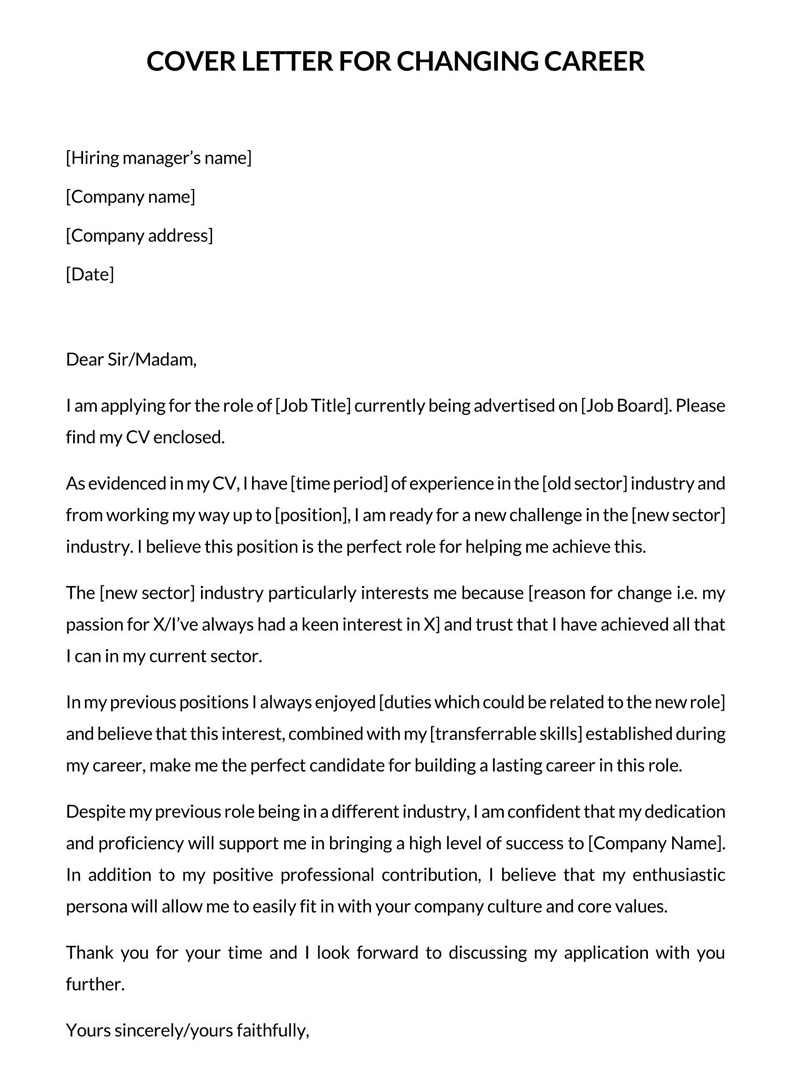
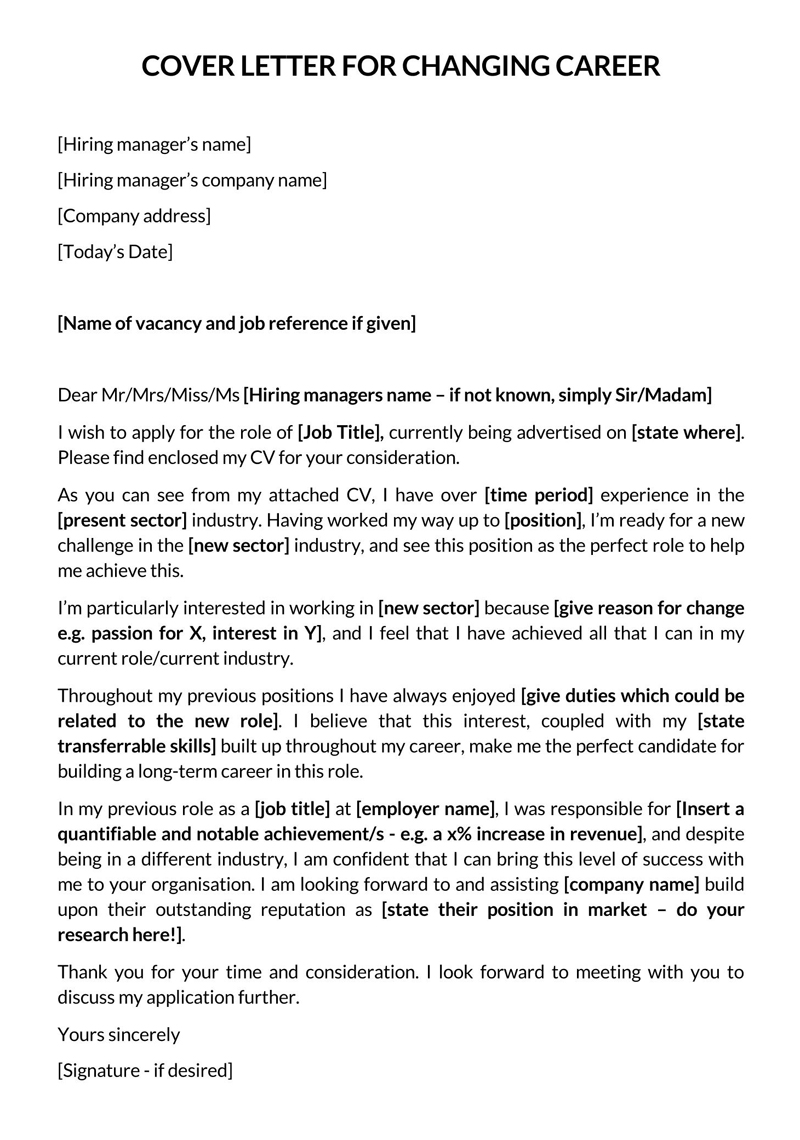
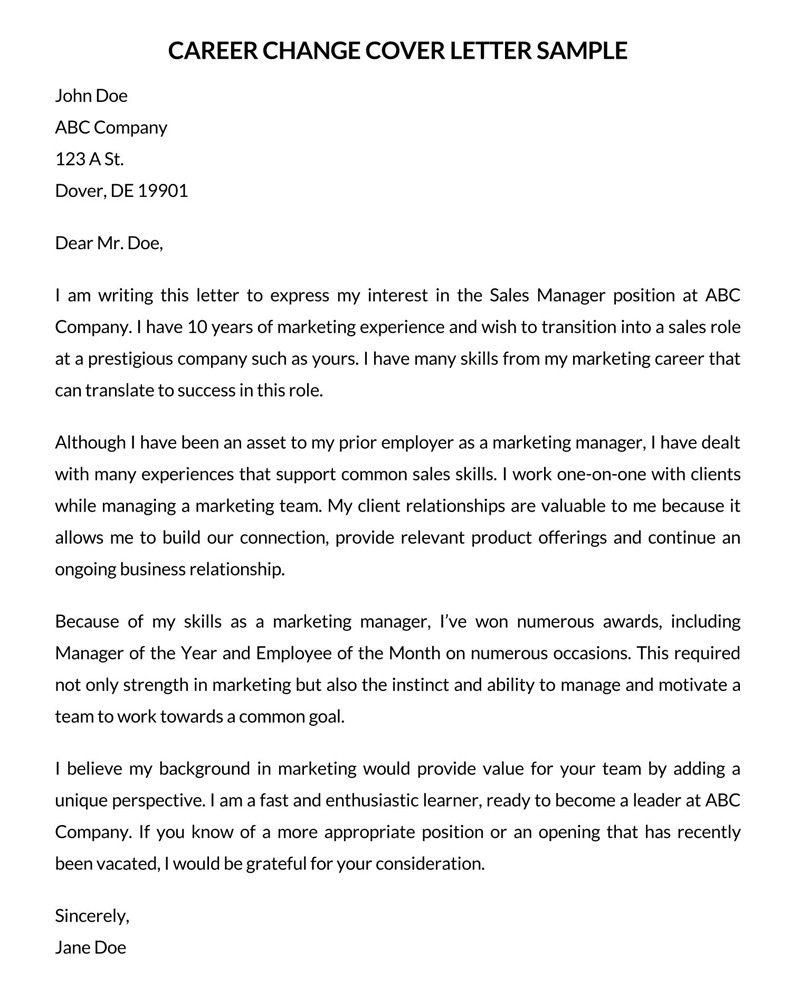
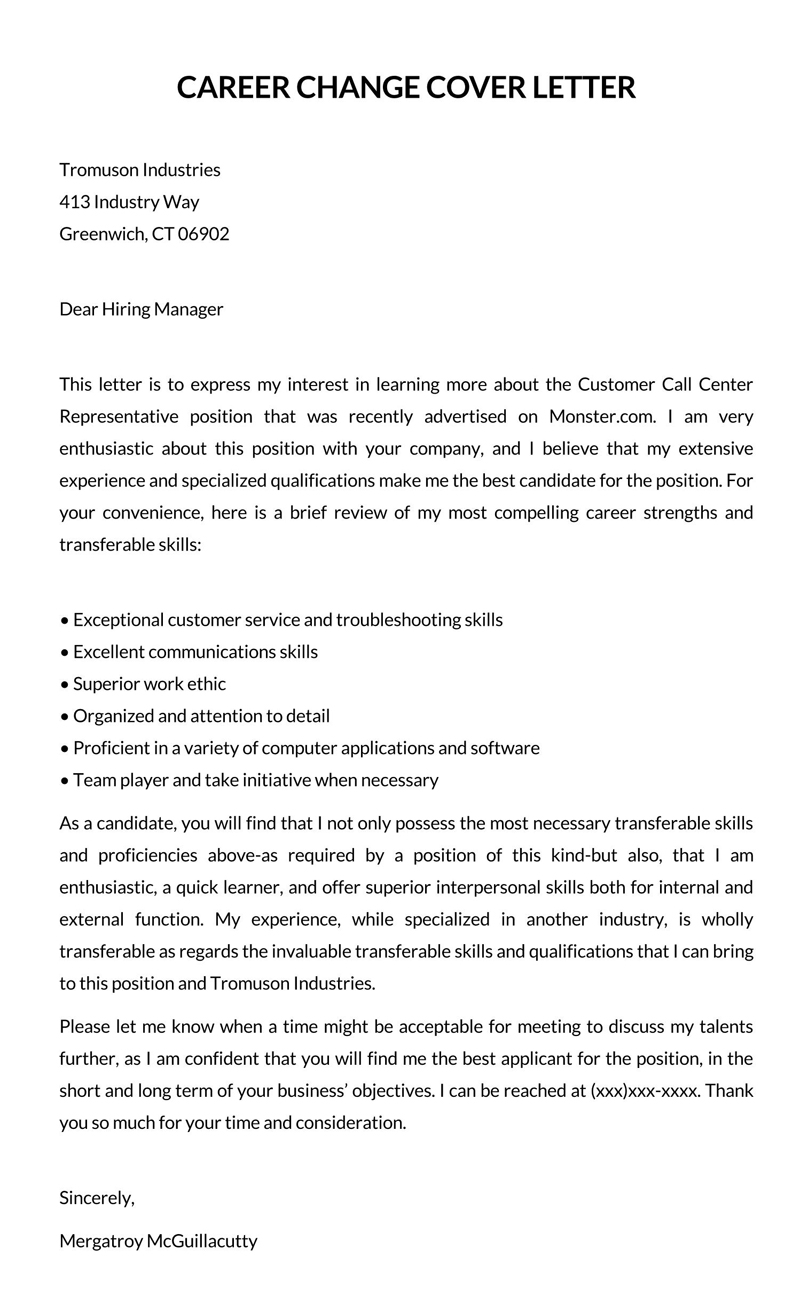
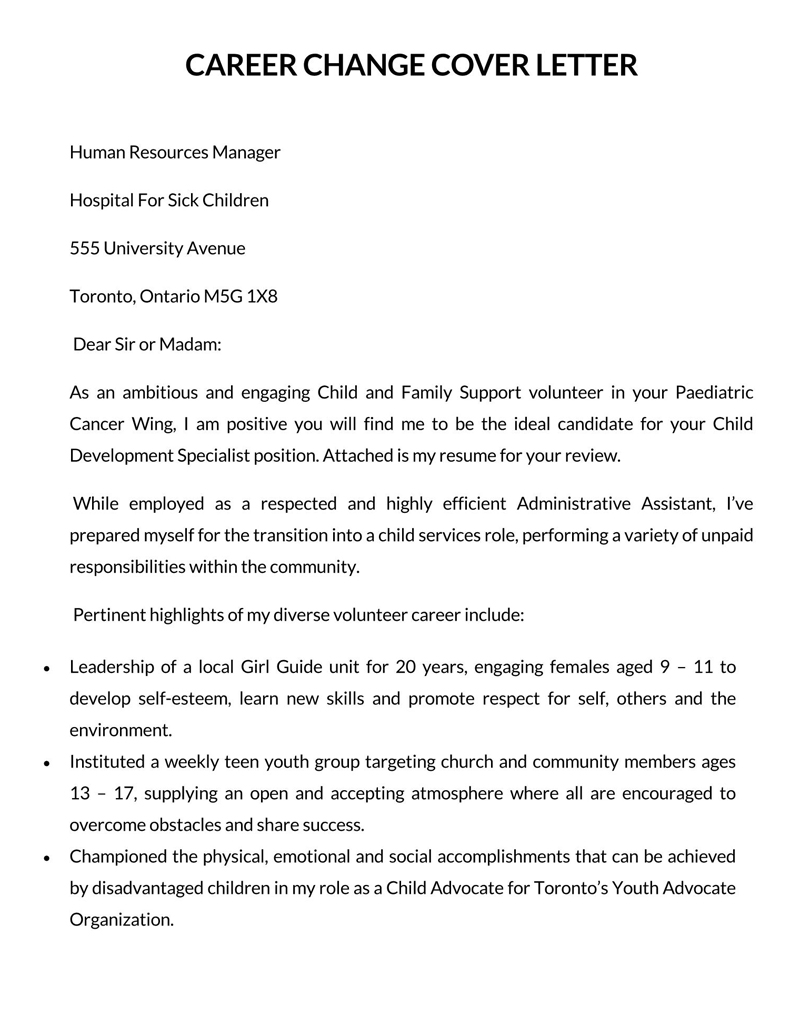
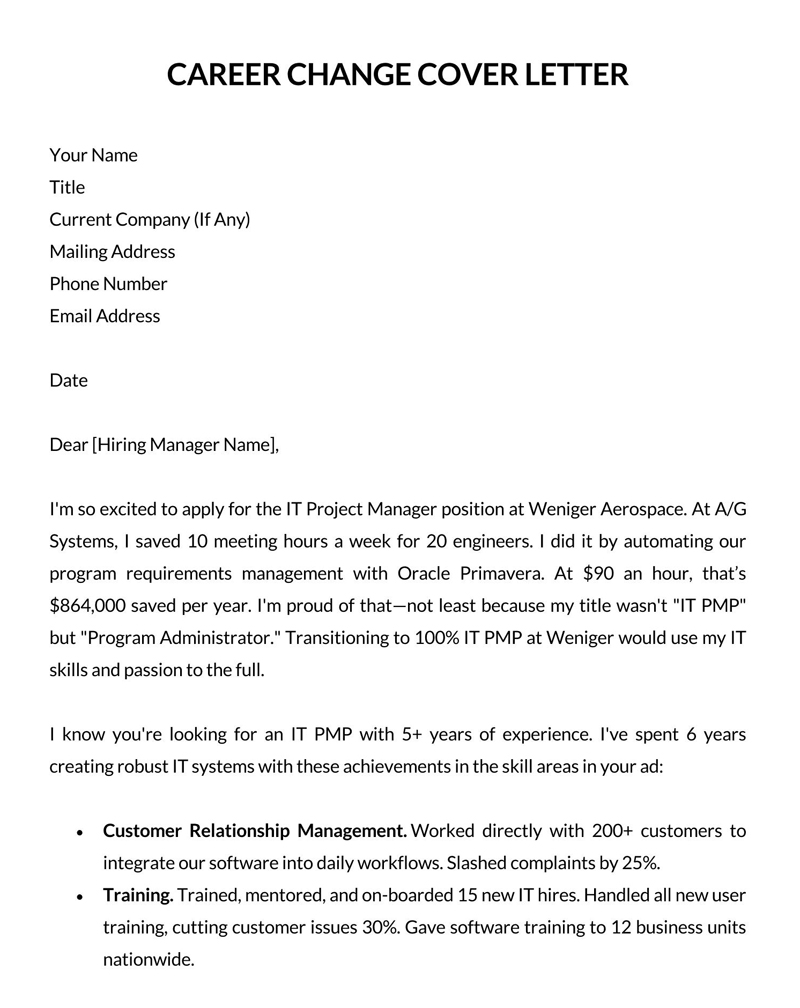
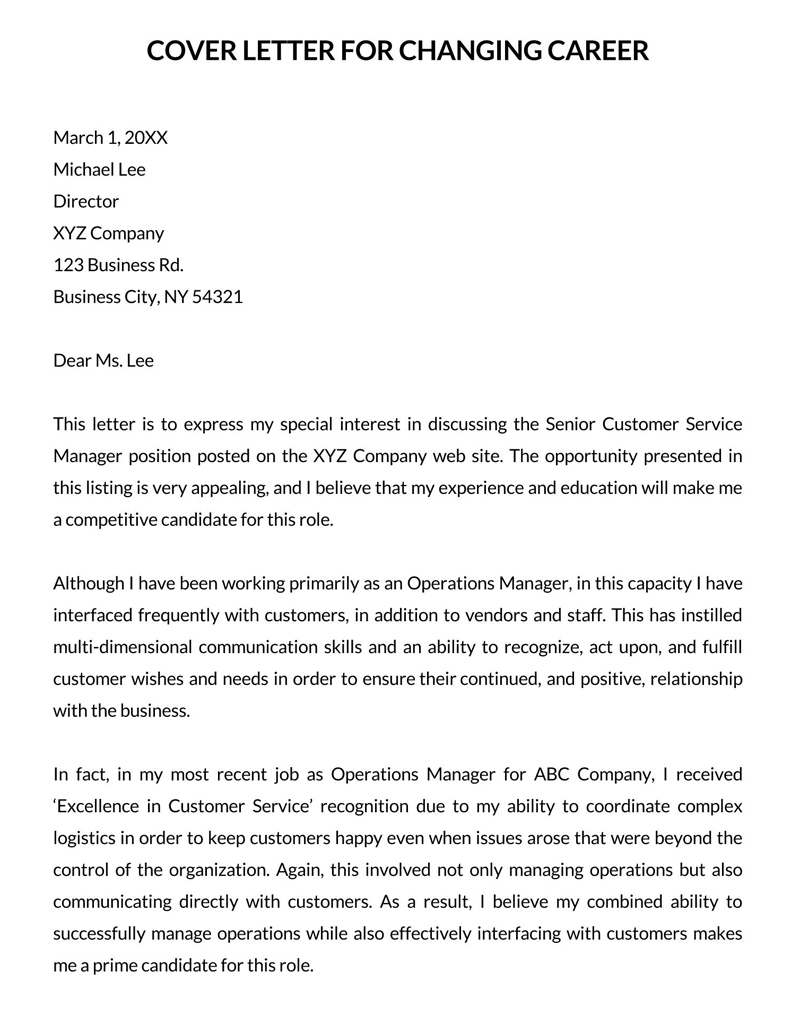
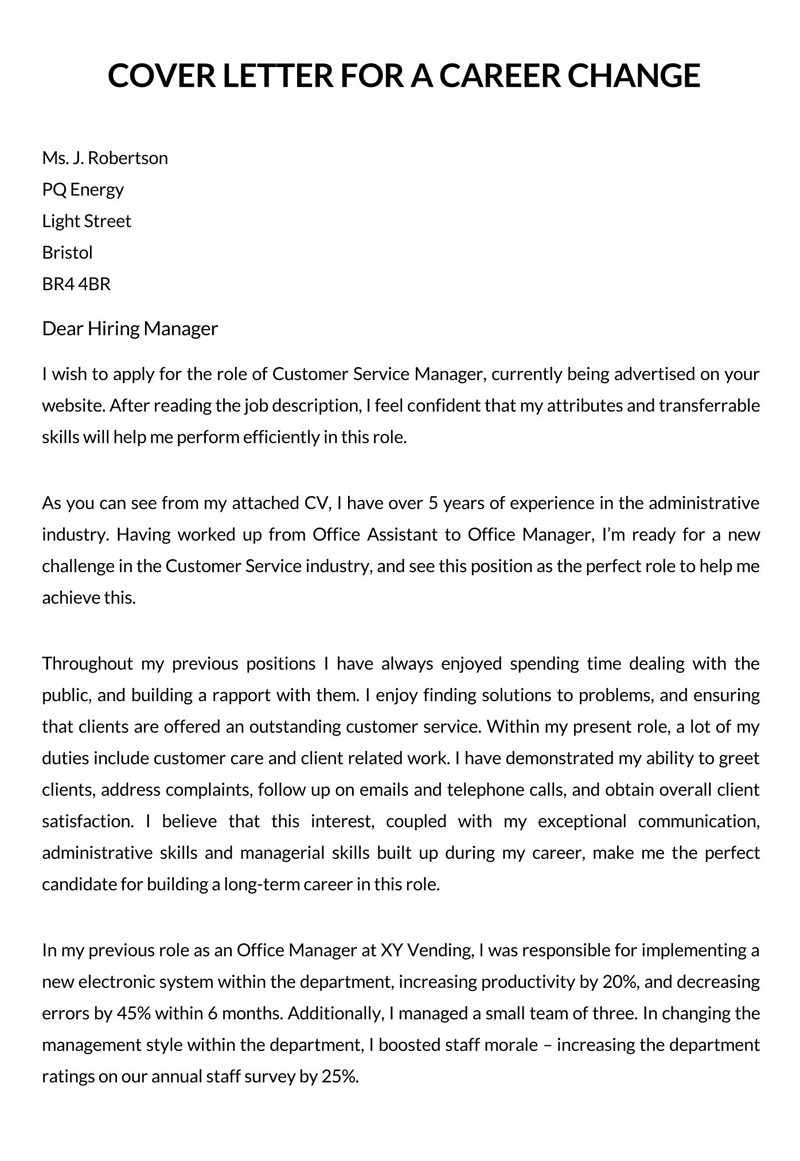
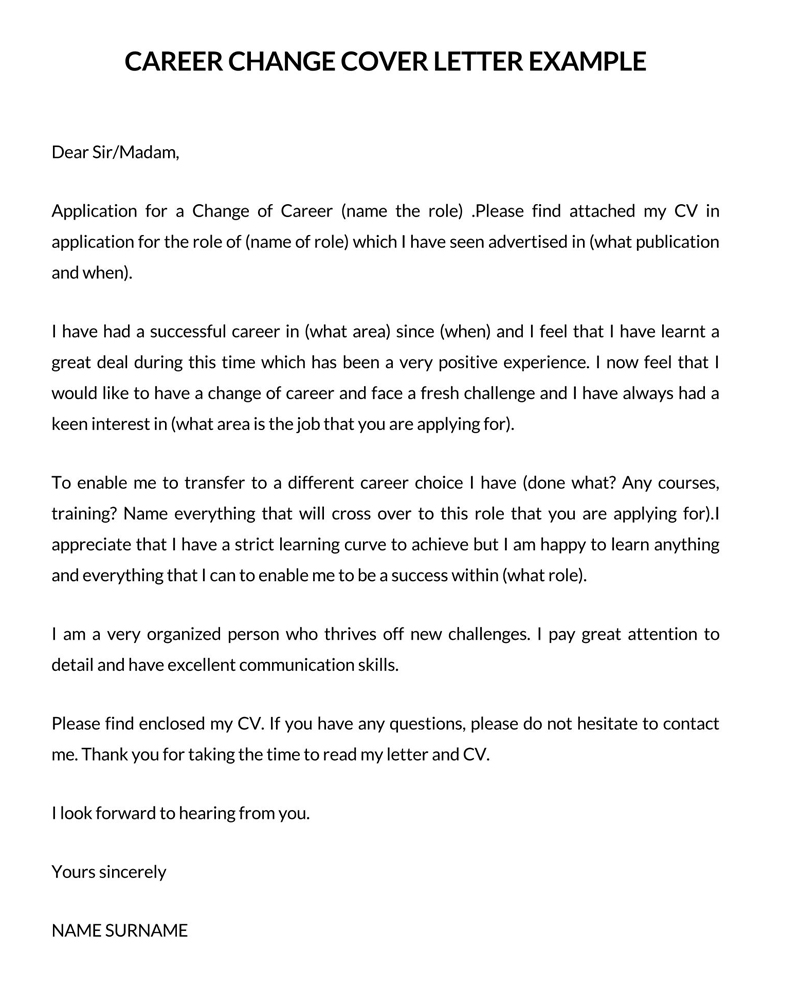
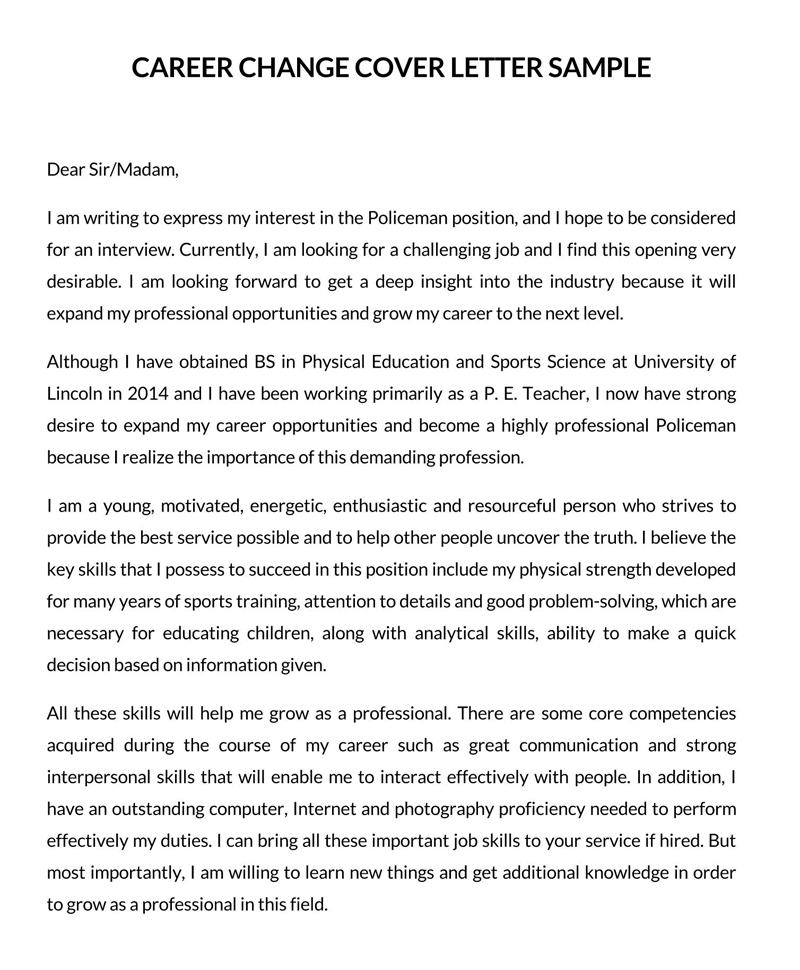
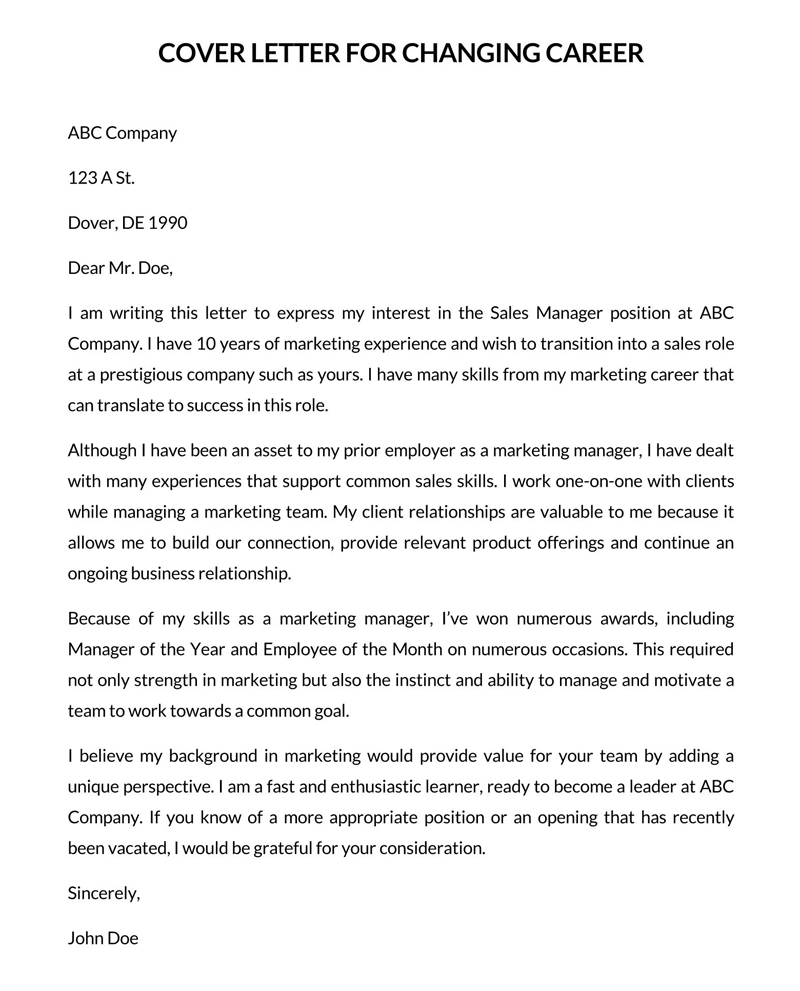
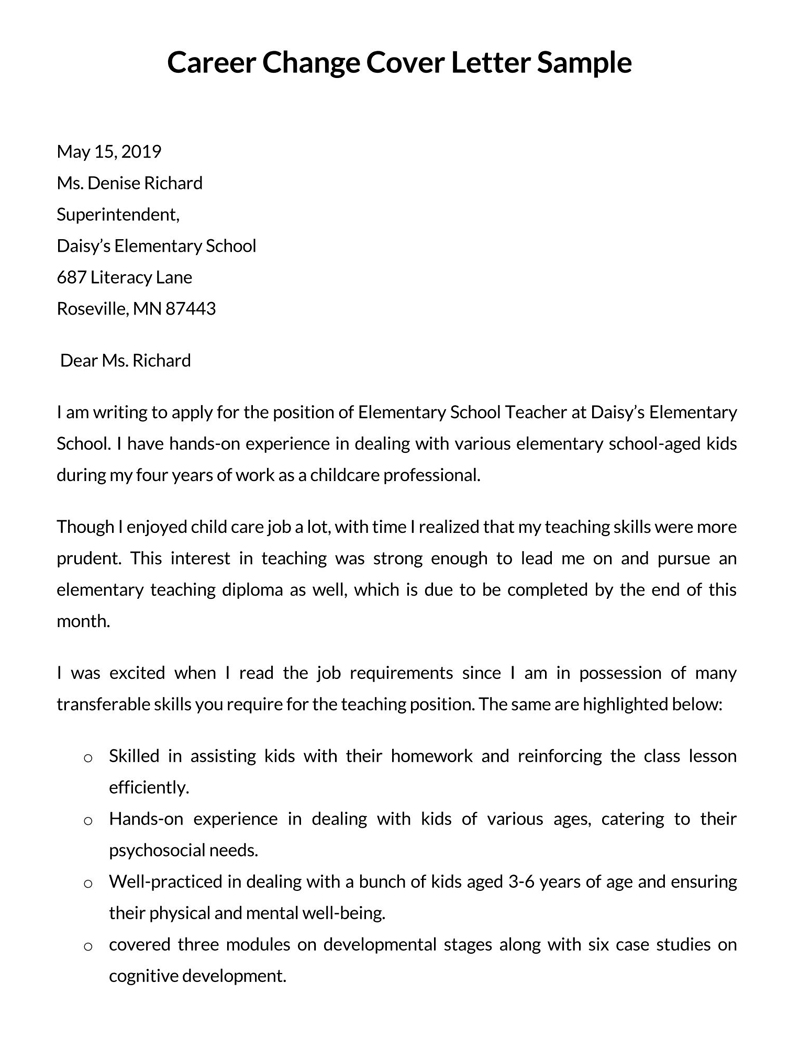
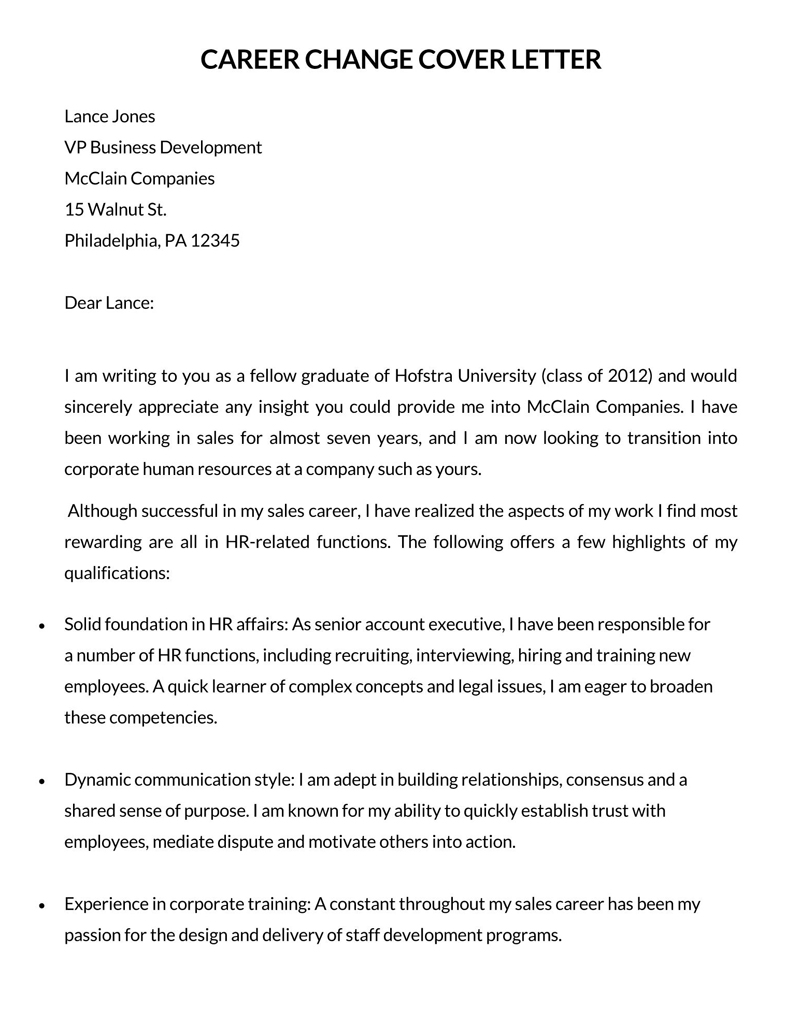
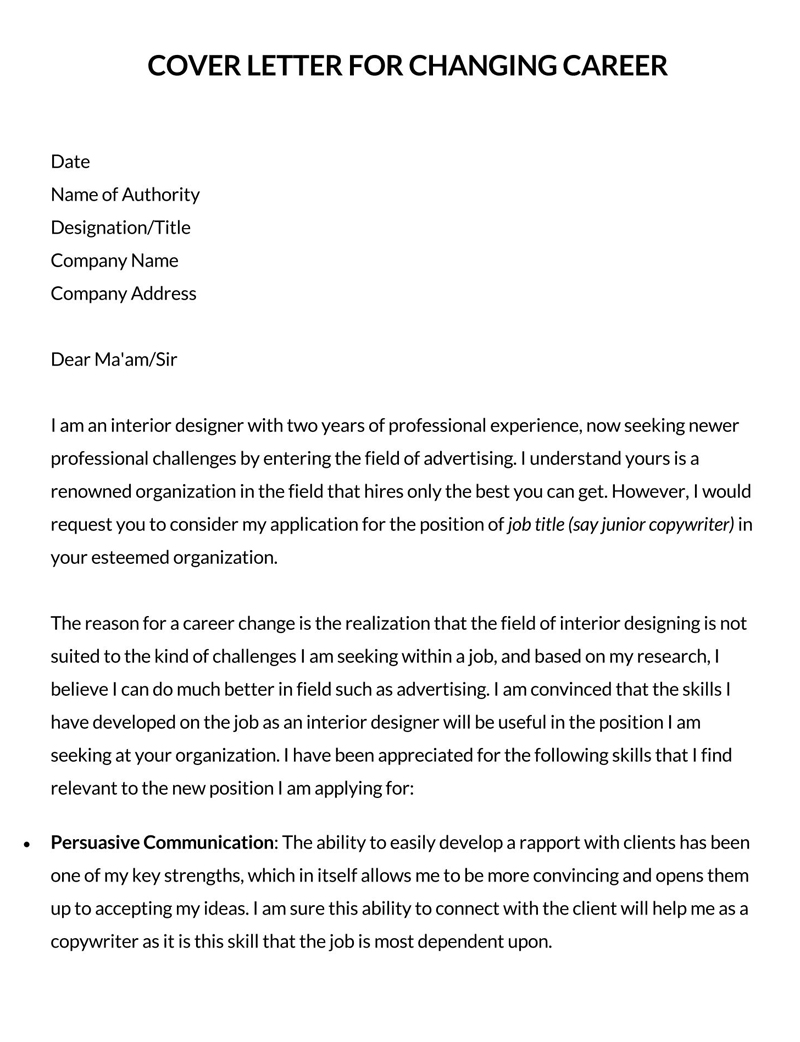
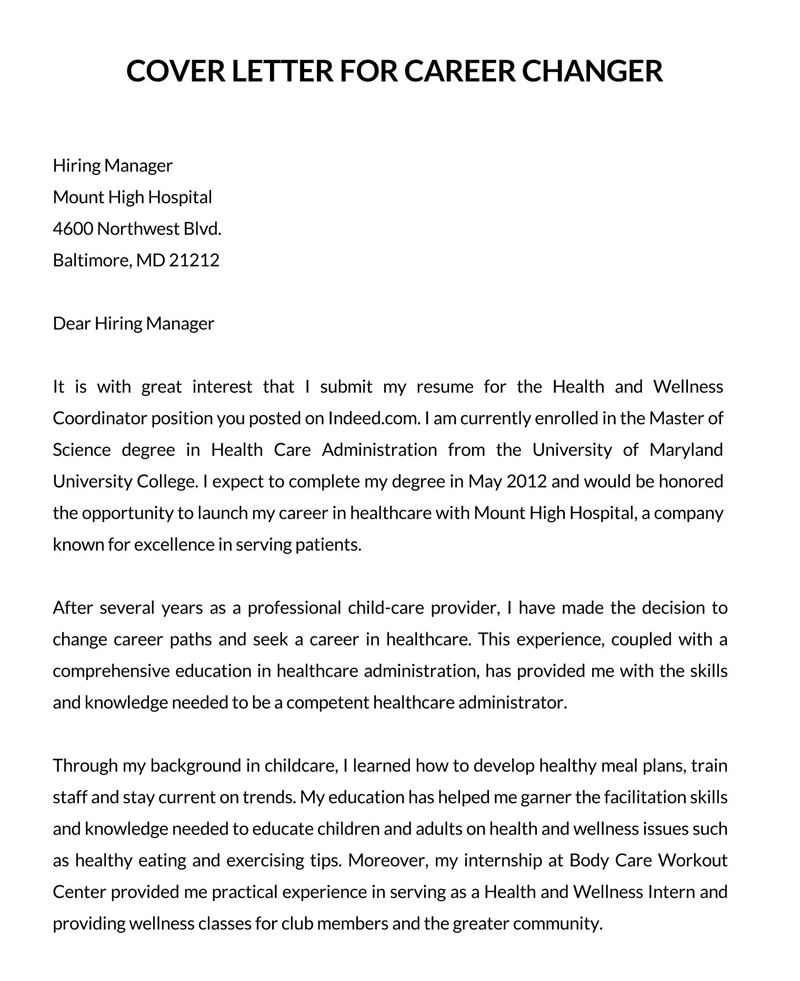
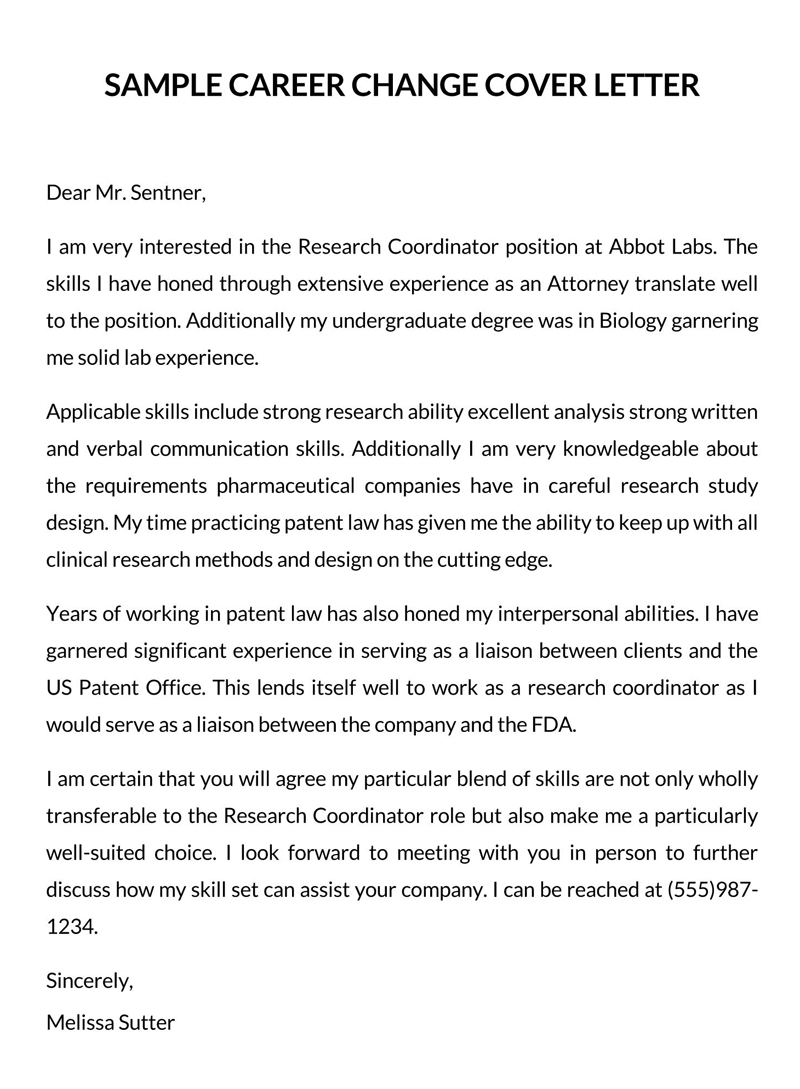
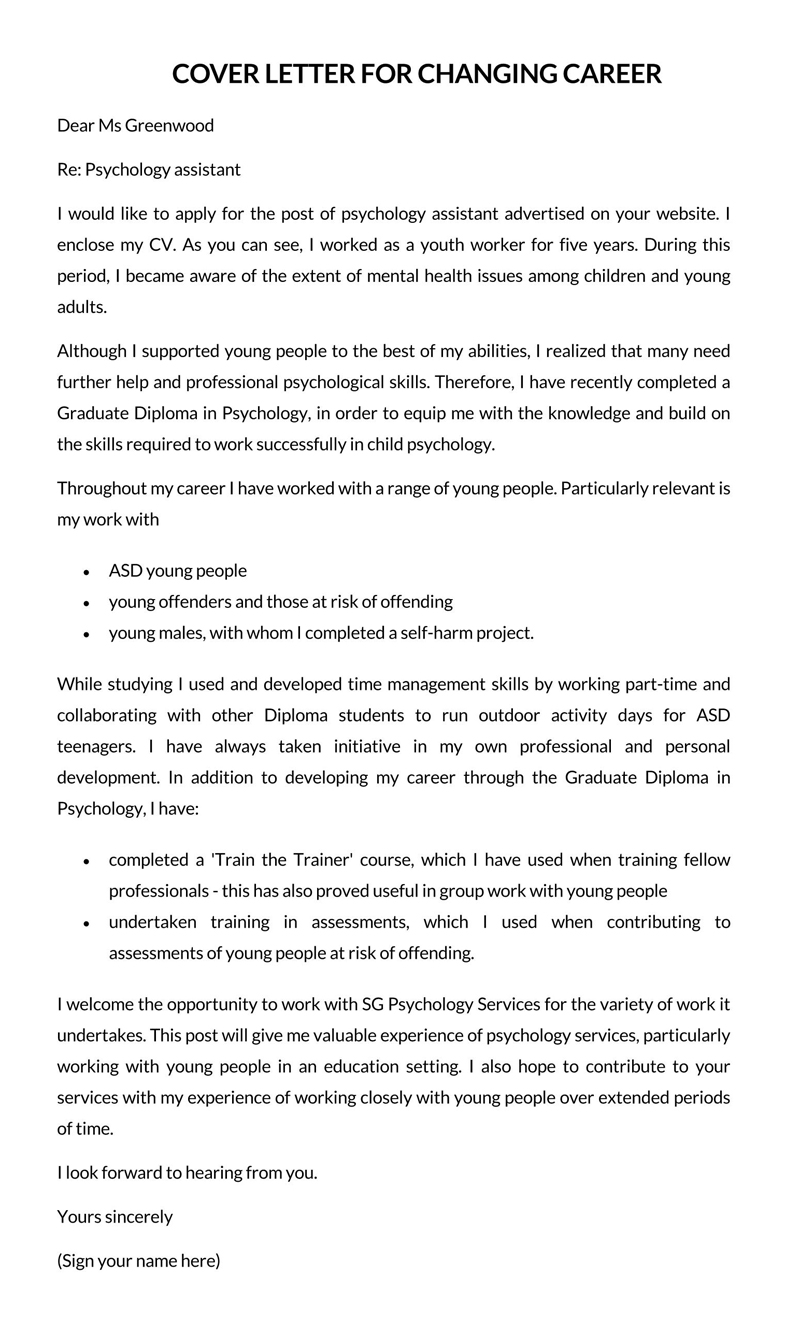
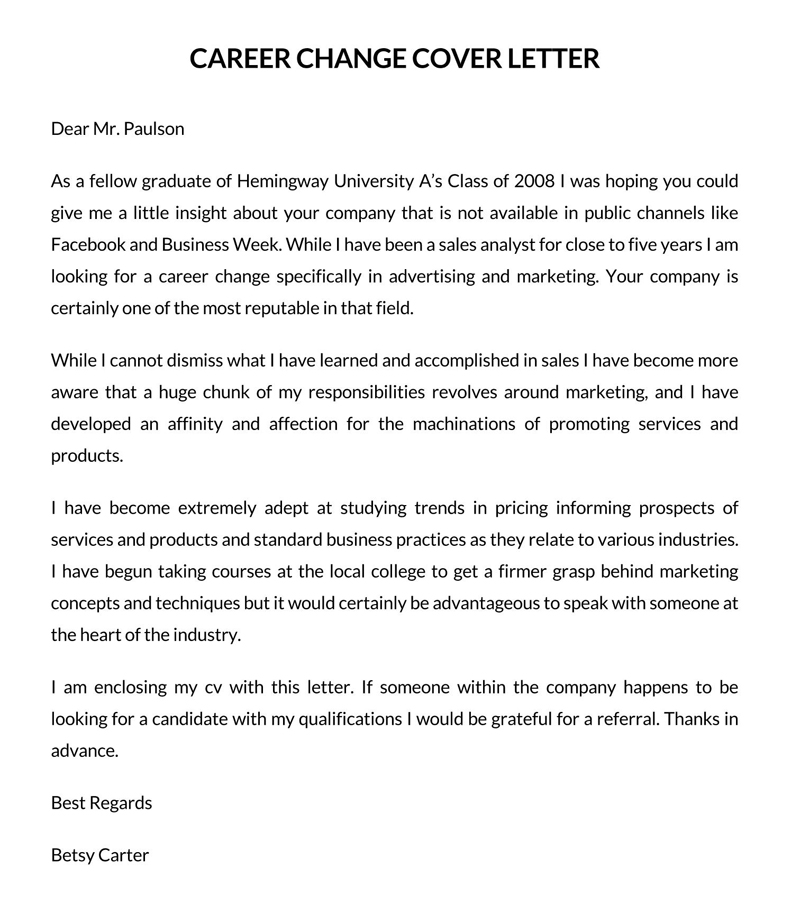
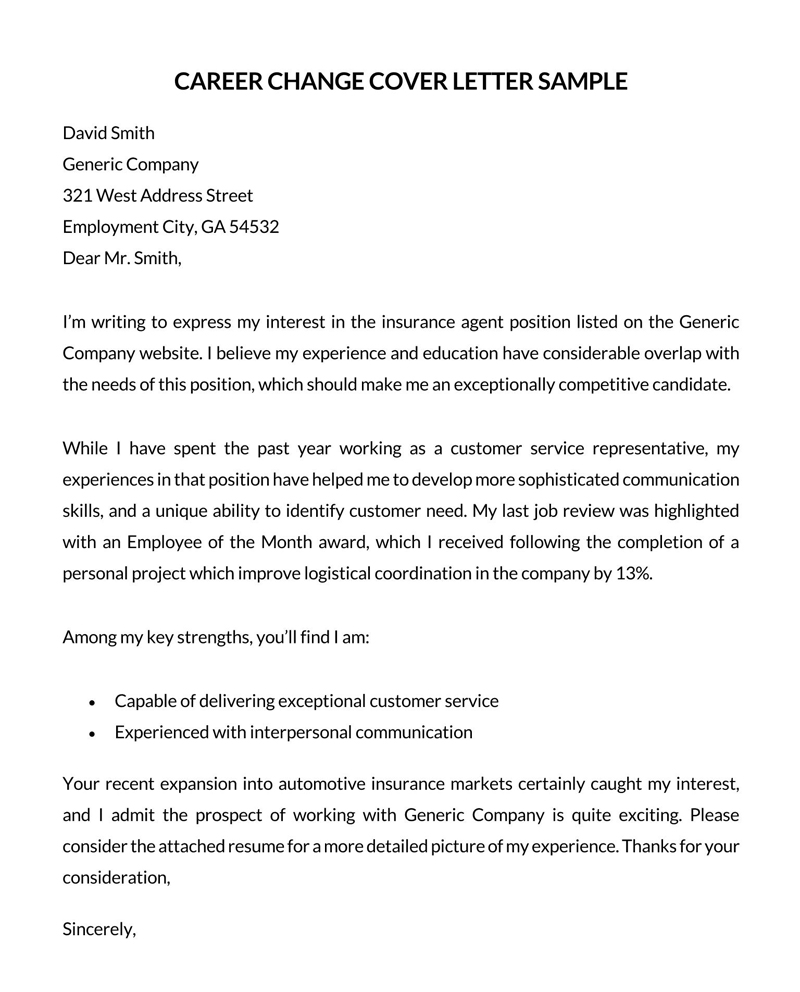
Guide to Writing It Efficiently
When writing a career change cover letter, you should adhere to a well-outlined step-by-step process.
The following is a guide on how to write this effective cover letter:
This letter should start with a header. The header should only be indicated in a physical copy and should not be included when an email is sent. The header must contain your full name, address, phone number, email, and date, while it should end with the hiring manager’s name, job title, and the company’s address.
EXAMPLE
Brian Smith
123 Main Street
567-537-6882
Johnsmith45@gmail.com
July 13, 2020
Lucy Black
Executive Manager
Green Stone Company
452 Miller Street
San Francisco CA,45378
2. Greeting
Next, you should indicate a greeting that directly addresses the hiring manager by first and last name. The hiring manager’s name can be obtained from the company’s website, linked in page, or the job posting.
EXAMPLE
Dear Creative Director hiring team,
Dear Ms. Alan Green,
3. Introduction
The introductory paragraph of a cover letter for career change provides you with an opportunity to impress the hiring manager from the onset and to make an excellent first impression.
The following details should be outlined in the introduction:
3.1. Introduce yourself
The introduction of this letter should explain who you are and why the letter has been written. The letter should also contain a statement explaining why you are the perfect candidate for the job by highlighting your valuable skills, experiences, or achievements.
My name is Brian Smith, and I am writing to express my interest in the position of Creative Director at Greens Stone Company. My experiences as an art director at Bright Light LLC make me a competitive candidate for the position.
EXAMPLE
My name is Brian Smith, and I am writing to express my interest in the position of Creative Director at Greens Stone Company. My experiences as an art director at Bright Light LLC make me a competitive candidate for the position.
3.2. Get the reader’s attention
You should strive to write a statement that draws the reader in. Writing a captivating statement will help grab the hiring manager’s attention. You can achieve this by highlighting an experience that is relevant to the job.
EXAMPLE
Building a brand image that customers can trust has been a big part of my job. It has helped ensure customer loyalty and familiarity with our brand. However, I want to be part of the bigger picture when it comes to brand identity. I believe that working as a Creative Director at Greenstone will allow me to do that.
3.3. Show your excitement
You should also express excitement in the introductory paragraph of the cover letter. Expressing enthusiasm about the position helps show the hiring manager that you value the role and the company. When expressing excitement., you should include admirable details about the company such as its mission, values, reputation, or product.
EXAMPLE
I am excited to be applying to a company that puts its customers first. Greenstone company products are known and trusted because the customer’s experiences are taken into consideration. This, for me, is important as I always strive to ensure that the customer’s voice is part of the brand image.
4. Body of the cover letter
The career change cover letter’s body enables you to provide compelling information on why you feel you are perfect for the job by outlining the following information.
The details provided in the body paragraphs provide more insight into your capabilities are:
4.1. Why do you want to change your career?
The body should begin by explaining why you are interested in making a career change. The explanation provided enables the hiring manager to understand your decision to make the change. The hiring manager will, therefore, be able to look past your unconventional background.
My decision to make this significant career change was prompted by a recent campaign that I was a part of. While working on the project, I realized what little input my team and I had on the final product. This realization prompted me to consider an even high position that would allow me to take a holistic approach to my work.
4.2. Emphasize your transferable skills
This letter should then highlight skills possessed by you that can easily be transferred to the new position. The skills identified should match those of the previous role. Both hard skills like computer literacy and soft skill like time management, and attention to detail, among others, can be indicated in the cover letter. At least three to five transferable skills should be briefly explained.
EXAMPLE
A creative director should be able to implement the company’s vision. My many years as an art director have allowed me to hone this skill. I am also no stranger to delivering work on schedule. I am accustomed to teamwork and department coordination to help achieve the goal of the campaign.
4.3. Highlight your extraordinary performance
You should also highlight relevant achievements from the previous position that help show the hiring manager that you can be a valuable asset to the company. Finally, you should relate the achievements mentioned to the new position. The incorporation of figures when describing the impact of the achievements helps strengthen the example provided.
EXAMPLE
Last year Bright Light LLC recognized my contribution to its product rebranding campaign. As a result, I was placed in charge of the company’s rebranding campaign temporarily. A survey conducted by the company showed that the work done by my team and I helped increase our customer base by 45%. This only shows that I can adapt to the role to yield desirable results when placed in a higher, more influential position.
4.4. Show passion
Showing passion for the company or industry can help set you apart from other qualified applicants by explaining why they are excited about the opportunity to work with the company. In addition, a personal explanation of where the passion comes from and how it will impact the duties and responsibilities of the role should be provided.
EXAMPLE
My passion lies in providing a holistic campaign that caters to both the company and its clients. Working in a company and position that enables me to do this will help unleash my full potential. I believe that Greenstone is the perfect place to do this.
4.5. Prove you understand the company
You should identify the company’s values by conducting online research or speaking to an individual who works in the company. The focus should be placed on employees who occupy a similar role to what you are applying for.
EXAMPLE
Your corporate vision of ‘Focusing on customer experience’ resonates with me. Like creative directing, art is a customer-centered career path though it may at times seem aesthetic-based. Centering my work around the company’s clients helps inform my work.
5. Conclusion
The cover letter for career change should end with a firm conclusion. The concluding paragraphs are your last chance to make an impression on the hiring manager.
The conclusion should include the following information:
5.1. Bring it all together
The final paragraph should be persuasive to bring all the information together to outline what you can do for the company.
EXAMPLE
I believe my skills can improve the output of your creative department.
5.2. Closing remarks
The closing remarks should express your willingness to further discuss the position with the hiring manager. You should also indicate a call to action. Finally, gratitude should be expressed for the time taken by the hiring manager to read the letter.
EXAMPLE
I look forward to the interview where we can discuss my application further in person. Please feel free to contact me with any questions you may have. Thank you for your time and consideration.
5.3. Signatures
You should end the cover letter with an appropriate professional sign-off phrase such as ‘Sincerely,’ ‘Regards, ‘among others. Your name should be indicated below the phrase.
EXAMPLE
Sincerely,
Brian Smith
Career Change Cover Letter Template
[Job Seeker’s Name]
[Address]
Phone number
[Date]
[ Hiring manager’s name]
[Job title]
[ Hiring manager’s Company Name]
[Company Address]
Dear[Hiring manager’s name]
I am witting to express my interest in the [job title] which I discovered on [ name of the job website, contact or board]. For the last [period], I have been working in a[ previous position]. As a result, I have gained many transferable skills which I believe will apply to the position.
My interest in the industry is due to[ give a reason for wanting to transition]. I have developed skills such as[indicate skills that relate to the position]which I believe apply to [ new position]. Working as a [ previous position] enabled me to [state relevant accomplishment].
I believe that my background in [ previous position] makes me a unique and valuable candidate worth considering. I look forward to discussing my qualification in person.
Sincerely,
[Job seeker’s name]
Career Change Cover Letter Samples
In the section that follows, two sample cover letters are provided as helpful examples to help those who are thinking about changing careers create effective cover letters.
Sample 01
Dear Mr. Alan Green,
My name is Emily Johnson, and I am reaching out to express my keen interest in the role of Marketing Manager at Orion Tech Solutions. With a background in journalism and recent experience as a content creator at MediaFlow, I believe I bring a unique perspective and set of skills that align well with this position.
My journey in media has always been driven by a passion for storytelling and engaging audiences. This passion, coupled with my desire to impact a larger audience, has drawn me to Orion Tech Solutions. Your commitment to innovative technology solutions and customer-centric approach is something I deeply admire and am excited to contribute to.
The decision to pivot towards marketing was sparked by a collaborative project with our marketing team, where I realized the immense potential of combining storytelling with strategic marketing. I bring a strong skill set in content creation, audience analysis, and digital communications, all of which are crucial for a successful marketing campaign.
My tenure at MediaFlow saw me leading several high-impact projects. Most notably, I directed a digital campaign that resulted in a 30% increase in online engagement within six months. This achievement is a testament to my ability to adapt to and excel in diverse roles.
I am enthusiastic about the possibility of bringing my storytelling skills and creative approach to Orion Tech Solutions. Your focus on harnessing technology to improve the user experience deeply resonates with my professional ethos.
In conclusion, I am confident that my background, combined with my passion for marketing and technology, would make a significant contribution to your team. I eagerly anticipate the opportunity to discuss how my experience and vision align with the goals of Orion Tech Solutions.
Thank you for considering my application. I look forward to the possibility of contributing to your esteemed company and am available for an interview at your earliest convenience.
Sincerely,
Emily Johnson
Sample 02
Dear Hiring Team at Quantum Finance,
I am Thomas Richards, and I am writing to express my interest in the Financial Analyst position at Quantum Finance. My extensive experience in software engineering at TechGenius, coupled with my deep interest in financial analytics, positions me uniquely for this role.
I have always been fascinated by the financial world and its impact on global economies. The innovative financial solutions offered by Quantum Finance, along with your commitment to ethical practices, have greatly impressed me and fueled my desire to be part of your esteemed organization.
My career change was inspired by my involvement in developing a financial analysis tool at TechGenius. This experience exposed me to the intricacies of financial data and sparked a passion for financial analytics. I possess strong analytical skills, a keen eye for detail, and a profound understanding of data interpretation, all of which are essential in the financial sector.
During my time at TechGenius, I led a team that successfully developed a predictive analytics tool, which increased operational efficiency by 40%. This achievement demonstrates my capacity to lead and innovate, qualities that I am eager to bring to Quantum Finance.
My passion lies in leveraging technology to streamline financial processes and enhance accuracy in data analysis. Working at Quantum Finance will allow me to apply my technical skills in a financial context, furthering my professional growth and contributing meaningfully to your team.
In summary, I am excited about the opportunity to merge my technical expertise with my newfound interest in finance at Quantum Finance. I am keen to further discuss how my unique background and skills can contribute to your dynamic team.
Thank you for considering my application. I am looking forward to the opportunity to explore this exciting new path with Quantum Finance.
Best regards,
Thomas Richards
Key Takeaways
Several key elements make these sample letters effective. These elements are instrumental in guiding someone who is writing a cover letter for a career transition.
- Both letters demonstrate how to weave personal career stories into compelling narratives. This storytelling technique helps career changers explain their transition logically and emotionally, making it easier for employers to understand and appreciate their career journey.
- The letters provide excellent examples of how to highlight transferable skills. Career changers often possess skills from their previous roles that are valuable in new contexts. These samples show how to identify and present these skills effectively, making the candidate’s background seem not just relevant but advantageous.
- The letters are tailored to specific roles and industries, demonstrating the importance of customization. They underscore the need to research the target company and position and to align the cover letter’s content with the company’s values, culture, and needs.
- The letters exemplify how to express genuine enthusiasm and commitment to a new field. For career changers, it’s crucial to convey that their decision is well-thought-out and driven by genuine interest, not mere circumstance.
- These samples provide a blueprint for addressing the career change head-on, rather than avoiding the topic. They show how to turn potential concerns about a lack of direct experience into a discussion about diverse perspectives and adaptability.
- The letters encourage creativity in how applicants present their past experiences and future aspirations. They illustrate that there are multiple ways to frame a career journey positively and engagingly.
- The cover letters serve as a guide on how to articulate one’s professional goals and vision in the new field. This clarity not only helps the potential employer understand the candidate’s direction but also assists the candidate in solidifying their own goals.
In essence, these cover letter samples are invaluable resources for career change applicants. They provide a framework for constructing a persuasive narrative, showcasing the value of diverse experiences, and positioning oneself strategically in a new industry or role.
Tips to Keep in Mind
Writing a compelling cover letter can ensure that you are viewed as a potential asset. Making specific considerations before and during the writing process will help strengthen your position.
The following tips can help enhance the effectiveness of the career change cover letter:
Research the company
Before a cover letter can be written, you should research the company and the requirements for the position. Conducting adequate research ensures that the information provided by you is tailored to the company and the position.
You also appear more knowledgeable about the position and company; hence are likely to appear on the hiring manager’s list of candidates for interview.
Get references
You can increase the chances of obtaining the position by having numerous reliable references. The reference letters will attest to your skills and experiences in the former position. The references should be professionals with in-depth knowledge about your career.
Your references may be former or current coworkers, managers, employers, mentors, advisors, teachers, or a report highlighting your achievements. You should indicate each reference’s name, job title, and contact information.
Explain your reasons
You should provide an apparent reason for the career change. There should also be an emphasis on your commitment to learn quickly and contribute to the company’s success. Your reason should be framed positively to keep in line with the information provided in the cover letter.
Send an email
As emails are a better mode of communication these days, so it is a good option to send your letter by email. When sending a cover letter for a career change via email, Your name and job title should be indicated in the subject line. You should then start the email message as the hiring manager’s details are not required. The email signature should contain the applicant’s contact details.
Final Remarks
Writing a cover letter for career change enables a job seeker to transition to a new position to highlight transferable skills. The cover letter and resume should be refocused to fit the applicant’s new position. It will help show the hiring manager that the job seeker can take on a new role. The hiring manager is also able to see how the job seeker stands out from the qualified applicants.
